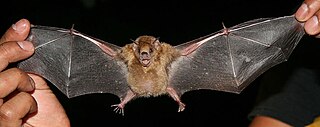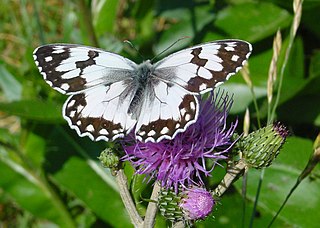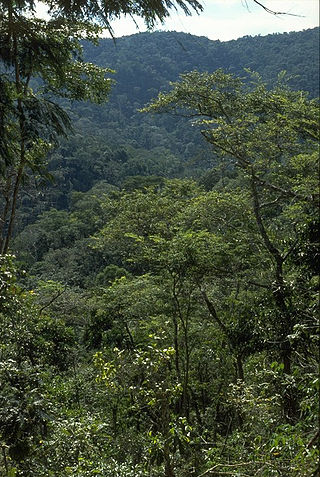
Lachesis is a genus of venomous pit vipers in the family Viperidae. Member species are found in forested areas of the Neotropics. The generic name refers to one of the Three Fates, Lachesis, who determined the length of the thread of life. Four species are currently recognized as being valid.
The Crotalinae, commonly known as pit vipers, or pit adders, are a subfamily of vipers found in Eurasia and the Americas. Like all other vipers, they are venomous. They are distinguished by the presence of a heat-sensing pit organ located between the eye and the nostril on both sides of the head. Currently, 23 genera and 155 species are recognized: These are also the only viperids found in the Americas. The groups of snakes represented here include rattlesnakes, lanceheads, and Asian pit vipers. The type genus for this subfamily is Crotalus, of which the type species is the timber rattlesnake, C. horridus.

Canaima National Park Guyana is a 30,000 km2 (12,000 sq mi) park in south-eastern Venezuela that roughly occupies the same area as the Gran Sabana region. It is located in Bolívar State, reaching the borders with Brazil and Guyana. The park was named a World Heritage Site by UNESCO.

Lachesis muta, also known as the Southern American bushmaster or Atlantic bushmaster, is a venomous pit viper species found in South America, as well as the island of Trinidad in the Caribbean. Two subspecies are currently recognized, including the nominate subspecies described here.

The little yellow-shouldered bat is a bat species from South and Central America. It is a frugivore and an effective seed disperser.
Indio Maíz Biological Reserve is situated on the southeastern corner of Nicaragua bordering the San Juan River and Costa Rica. Measuring about 3,180 square kilometers, it is one of the largest protected lowland forest system in Central America, the second largest lowland rainforest reserve in Nicaragua and is a key component in the proposed Mesoamerican Biological Corridor. It has previously been referred to as "the gem of Central American nature reserves" by UCLA biologists. Indio Maíz is rich in biodiversity, holding a higher number in species of trees, birds, and insects than all of Europe. In recent years, a growing timber and oil palm industry has led to increasing rates of deforestation along the northern and western flanks of Indio Maíz.

Metlapilcoatlus nummifer, commonly known as Mexican jumping pitviper or jumping viper, is a venomous pit viper species endemic to Mexico.

Lachesis stenophrys, commonly called the Central American bushmaster, is a species of venomous pit viper in the family Viperidae. The species is native to Central America.
Lachesis acrochorda, also known commonly as the Chocoan bushmaster, is a species of venomous pit viper in the family Viperidae. The species is native to Central America and South America.

Melanargia lachesis, the Iberian marbled white, is a butterfly species belonging to the family Nymphalidae.

Lachesis melanocephala is a species of venomous pit viper in the family Viperidae. The species is native to Costa Rica and Panama. There are no subspecies that are recognized as being valid.
Bothrops medusa is a venomous pitviper species endemic to Venezuela. No subspecies are currently recognized.

Feliciano Miguel Abdala Private Natural Heritage Reserve, formerly the Fazenda Montes Claros and then the Caratinga Biological Station, is a privately owned sustainable-use protected area in the state of Minas Gerais, Brazil. It contains an example of Atlantic Forest biome. The reserve is home to rare buffy-headed marmosets and to one of the last wild populations of northern muriqui woolly spider monkeys.

The Serranía de la Neblina National Park is a national park of Venezuela.

The Caquetá moist forests (NT0107) is an ecoregion of tropical moist broad leaf forest to the east of the Andes in the east of Colombia, with a small section in Brazil, in the Amazon biome. The forests are in the transition between the Guiana and Amazon regions, and have highly diverse flora and fauna. They are relatively intact, although they are mostly unprotected and are threatened with deforestation to create cattle pastures.

The Negro–Branco moist forests (NT0143) is an ecoregion of tropical moist broadleaf forest to the east of the Andes in southern Venezuela, eastern Colombia and northern Brazil, in the Amazon biome. It lies on the watershed between the Orinoco and Rio Negro basins. It includes both blackwater and whitewater rivers, creating different types of seasonally flooded forest. The vegetation is more typical of the Guiana region than the Amazon.

The Japurá–Solimões–Negro moist forests (NT0132) is an ecoregion of tropical moist broad leaf forest in the Amazon biome.

The Uatuma–Trombetas moist forests (NT0173) is an ecoregion in northwest Brazil in the Amazon biome. It covers the Amazon basin north of the Amazon River from close to the Atlantic Ocean to the Rio Negro west of Manaus. The ecoregion is relatively intact, although it has been damaged along the main rivers and around population centers.
Tepuihyla shushupe is a frog in the family Hylidae. Scientists know it exclusively from the site of collection: The headwaters of the rivers Ere and Campuya near the Colombia border within Peru. They collected the sample 145 meters above sea level.













